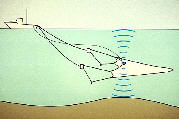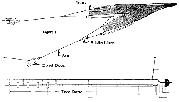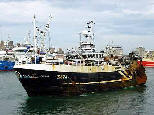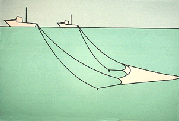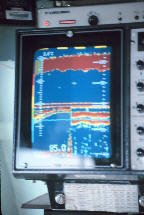EUROPEAN CETACEAN BYCATCH CAMPAIGN
"Man is but a strand in the complex web of life"
"Man is but a strand in the complex web of life"
Midwater Trawls.
A midwater trawl consists of a cone shaped body, normally made of four panels, ending in a codend with lateral wings extending forward from the opening.
It is usually much larger than a bottom trawl and designed and rigged to fish in midwater, including in the surface water.
The front parts are sometimes made with very large meshes or ropes, which herd the targeted fish inwards so that they can be overtaken by smaller meshes in the aft trawl sections.
The horizontal opening is maintained either by otter boards or by towing the net with two boats, pair trawling.
Floats on the headline and weights on the groundline often maintain the vertical opening. Modern large midwater trawls, however, are rigged in such a way that floats are not required, relying on downward forces from weights to keep the vertical opening open during fishing.
Midwater trawling is carried out mainly at sea, on the continental shelf, but can be carried out in deeper waters in most cases it is a single species fishery.
The target species can be demersal fish, but usually the target species are pelagic species such as mackerel, herring, tuna, pilchard, and sea bass.
There is no impact on bottom habitats and bottom structures. However, there is overwhelming evidence to suggest that midwater trawling results in high levels of cetacean bycatch.
Pair trawlers fishing for pelagic species have the highest levels of dolphin bycatch.
Midwater Otter Trawls.
A midwater otter trawl is a cone-
Floats and/or sail kites on the headline and weights on the groundline provide for the vertical opening.
Large modern midwater trawls are rigged in such a way that the weights in front of and along the groundline provide for the vertical opening of the trawl.
Midwater Pair Trawls.
A midwater pair trawl has roughly similar design as other midwater trawls.
Pair trawls can, however, be designed to have a more rectangular opening than ordinary midwater otter trawls, and be rigged with two towing warps from each vessel, or alternatively with one towing warp from each vessel and a bridle arrangement.
Pair trawls can be towed very close to the surface, and the herding effect on fish by the two vessels, increases the capture efficiency in shallow waters and at the surface.
Midwater trawling is carried out mainly at sea, on the continental shelf, sometimes in deeper waters as well as in some lakes. No impact on bottom habitats and bottom structures. In most cases it is a single species fishery,
Pelagic gears are used principally in the capture of shoaling species such as herring, mackerel, pilchard, sea bass, scad, blue whiting, tuna and sprats, which may be found close to the surface, in mid-
Electronic equipment such as sonar, net and catch monitors has greatly improved the precision of this method of fishing.
Normal towing speed is in the region of 3.75 knots, but may be increased to as high as 5 knots when fishing for mackerel.
Pelagic gear is also used for a number of seasonal fisheries such as that for hake in the Clyde and North Channel, the sea bass fishery in the English Channel, certain cod and haddock fisheries in the Irish Sea, and various targeted North Sea fisheries.
Pelagic trawls are towed at the appropriate level in the water column to intercept target shoal with gear depth being controlled by altering towing speed and/or warp length. Electronic equipment such as sonar, net and catch monitors has greatly improved the precision of this method of fishing.
Normal towing speed is in the region of 3.75 knots, but may be increased to as high as 5 knots when fishing mackerel.
Monitoring of the incidental catches of cetaceans in pelagic trawl fisheries has been very limited.
The studies which have been carried out indicate that these fisheries pose a significant threat to dolphins.
One study (Morizur et al, 1999) indicated that up to 50 dolphins might be taken in a single haul of a pelagic trawl .
When 11 pelagic trawl fisheries in the northeast Atlantic were observed (Morizur et al 1999), a variety of dolphin species were caught in four of the fisheries studied; the mackerel, pilchard, herring and sea bass fisheries.
Top
